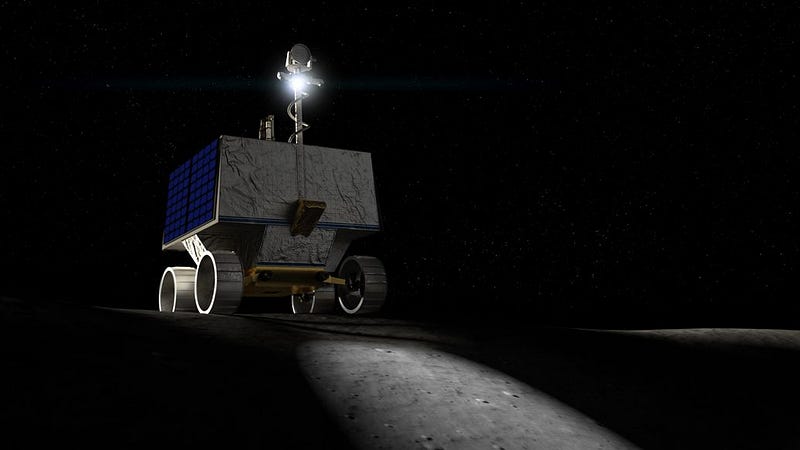Mapping the Moon's Ice: NASA's VIPER Rover Initiative
Written on
Chapter 1: Introduction to Lunar Exploration
NASA is embarking on an exciting mission to uncover the hidden treasures of the Moon's surface, specifically focusing on its ice reserves. Unlike Earth's abundant water, the Moon's H2O is scarce and largely fixed, making its exploration crucial for future lunar endeavors.

By Charlie Wood
Water is a plentiful resource on Earth, replenished by natural processes. In contrast, the Moon's water behaves more like precious metals, slowly accumulating over vast periods. Before we can establish ice extraction sites, identifying the locations of these resources is vital. To achieve this, NASA plans to deploy the Volatiles Investigating Polar Exploration Rover (VIPER) to the Moon. This rover, comparable in size to a golf cart, is slated to traverse the lunar south pole during the holiday season of 2022, conducting analyses to detect ice within the soil. The resulting map will be invaluable for scientists seeking to comprehend the origins of lunar water, as well as for astronauts who will rely on this resource.
Section 1.1: The Significance of Lunar Water
“We’re really at the crossroads of where science and exploration come together,” states Anthony Colaprete, VIPER's project scientist. Access to sufficient lunar water could provide essential resources for sustaining a lunar base. Aside from drinking, this water can be split into hydrogen for rocket fuel and oxygen for respiration, though the actual availability of usable water remains uncertain. Colaprete emphasizes the need to determine whether the water constitutes a substantial reserve akin to oil or natural gas.
Researchers estimate that the water present at each lunar pole could range from 100 million to 1 billion metric tons, which could support various Antarctic-style outposts. However, for larger space habitats, alternative sources may be necessary. For context, if a city like New York were to be relocated to a lunar pole, its daily consumption of one billion gallons would deplete the region in less than a year.
Subsection 1.1.1: Water Sources on the Moon
Evidence suggests that minuscule amounts of water cling to lunar dust, but the more promising findings stem from the Lunar Crater Observation and Sensing Satellite (LCROSS), which NASA deliberately crashed into the Moon's south pole in 2009. The debris revealed actual grains of water ice, akin to sugar mixed within coffee grounds, presenting a potential resource for astronauts. The ice can vaporize upon exposure to space, suggesting that collecting it might involve simply disturbing the soil and capturing the vapor.
Section 1.2: The VIPER Mission
VIPER will create a detailed three-dimensional map of the Moon's water resources by surveying the south pole, where sunlight creates perpetual shadows conducive to ice preservation. The rover will navigate the gentle slopes of ancient craters, where water has had ample time to collect. Utilizing three types of spectrometers, VIPER will analyze hydrogen molecules, continuously scanning the surface and probing underground. When it identifies a particularly damp area, it will employ a three-foot drill to extract subsurface samples for further examination.
Chapter 2: The Future of Lunar Resource Exploration
The rover's instruments will generate a regional resource map covering approximately a dozen miles, indicating the types of ice present in various locations. Should VIPER discover significant deposits, this map will aid future astronauts and contribute to what Colaprete calls a “resource model”—a scientific framework predicting water distribution and formation processes. The south pole's diverse environments offer VIPER an optimal opportunity to collect data that can be extrapolated across the Moon. Colaprete likens this approach to mineral exploration on Earth, emphasizing collaboration with the United States Geological Survey to adapt successful methodologies for lunar application.
NASA's VIPER Moon Rover: Robot Build Watch Party - YouTube
The resource model will serve as a comprehensive database for explorers and scientists alike, providing critical insights for establishing ice mining operations while also offering information on the origins of the water, such as whether it is from cometary sources or created through solar wind interactions.
VIPER signifies a monumental leap towards establishing a permanent human presence on the Moon. However, it also highlights the necessity of sustainable practices to manage the finite resources that have taken eons to accumulate. Adopting advanced mineral surveying and extraction techniques is essential for our success in space, but true sustainability will be key to our long-term survival on the lunar frontier.
Roaming the Moon with VIPER - YouTube